80 years ago the siege of Leningrad was completely lifted
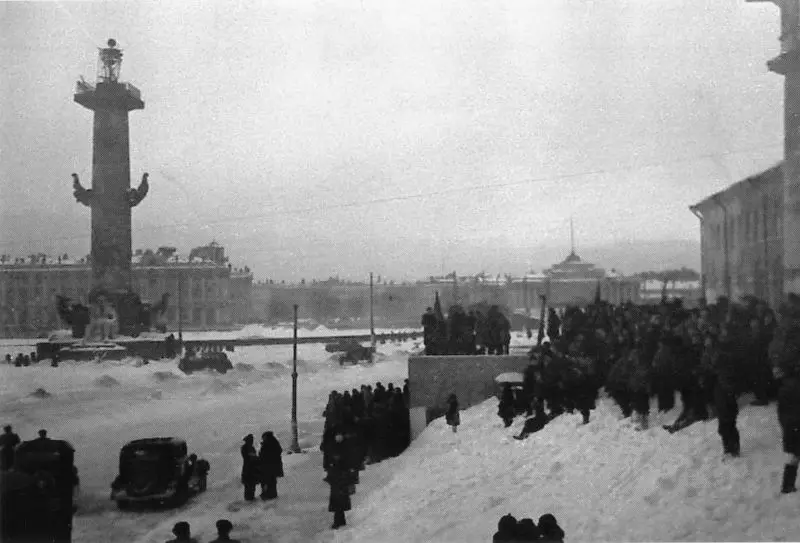
Residents of Leningrad at the stock exchange building meet the news of the lifting of the blockade of the city
On January 14, 1944, the Krasnoselsko-Ropshinsky operation of the Leningrad Front began. As a result, on January 27, the blockade was finally lifted. The German army was driven back 60–100 km, and the blockade fell 872 days after it began.
How did the Germans blockade Leningrad?
The German Army Group North (16th and 18th field armies, 4th tank group). The ground forces were supported by the 1st Air Fleet and the German Navy. Also in the north, in Scandinavia, the German Army Norway and two Finnish armies operated. They were supported by part of the forces of the 5th Air Force fleet and the Finnish Air Force.
Finland declared war on the USSR on June 26, 1941, and its army launched an offensive in the Murmansk and Karelian directions. The Finns attacked Leningrad on both sides of Lake Ladoga to link up with the Wehrmacht, which was moving from the southwest and south.
The Nazis sought to quickly break through to Leningrad and capture the second capital of the USSR, the most important strategic, economic and cultural center of the Union. Subsequently, the main forces of Army Group North were to turn south and take part in the capture of Moscow.
Hitler set the task of taking Leningrad as quickly as possible, clearing the Gulf of Finland of the Baltic Fleet, so that the sea would become a “German lake.” The Fuhrer believed that the fall of Leningrad and Moscow would lead to the “collapse of the Russians.”
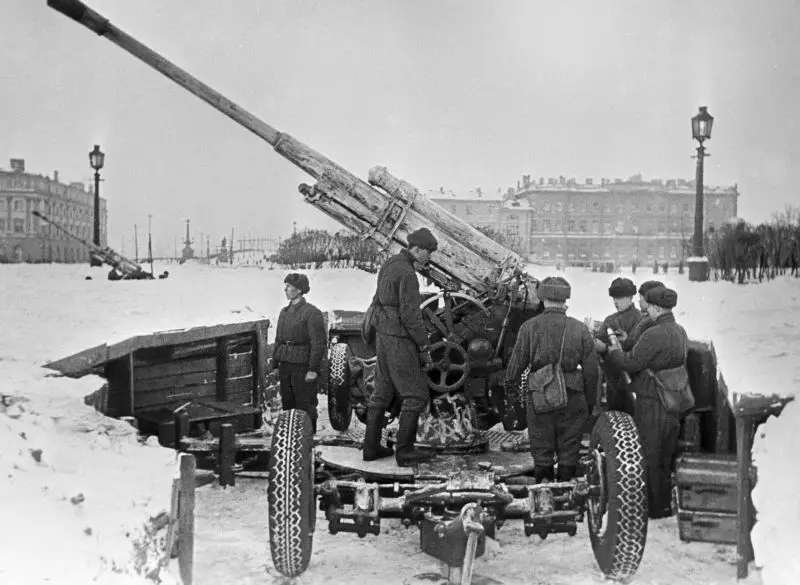
Soviet anti-aircraft gunners prepare an 85-mm anti-aircraft gun (52-K) for battle on the Field of Mars in Leningrad. February 1942
The Germans quickly advanced, occupied the Baltic states, and broke through to Novgorod and Leningrad. On August 7, the Wehrmacht cuts off the Tallinn group of the Red Army and the base of the Baltic Fleet. On August 28–30, the Baltic Fleet makes a dramatic transition from Tallinn to Kronstadt (Baltic tragedy. How the Baltic Fleet broke through to Kronstadt; Baltic Tsushima of the Soviet fleet). As a result, the Germans were unable to destroy the combat core of the Baltic Fleet, and the Soviet fleet strengthened the defense of Leningrad.
On August 8, 1941, the Germans went on the offensive in the Red Guard (Gatchina), Luga and Novgorod directions. After stubborn battles, the Nazis took Kingisepp on August 16, Novgorod on August 19 and Chudovo on August 20, and intercepted the Moscow-Leningrad railway. Developing the offensive, German troops occupied Luga on August 24, and Lyuban on the 25th. On August 28, the Germans captured Tosno, and on August 30, they reached the Neva, cutting the railways that connected Leningrad with the country. During fierce fighting, the enemy was stopped in the Krasnogvardeysk area. The Finnish army on the Karelian Isthmus pushed the Soviet 23rd Army to the 1939 border.
On September 6, 1941, the German Headquarters in Directive No. 35 demanded to encircle the Leningrad Russian group, take Shlisselburg and blockade Kronstadt. On September 8, the Germans, having broken through the Soviet defenses in the Mgi area, took Shlisselburg and surrounded Leningrad from land. On September 12, the Nazis took Krasnoye Selo and reached the immediate approaches to Leningrad.
On September 16, troops of Army Group North between Strelnya and Uritsk broke through to the Gulf of Finland, cutting off units of the 8th Army from the main forces of the Leningrad group. The Oranienbaum bridgehead was formed. On September 17, the Germans captured Pavlov and entered Pushkin. Fierce fighting took place near the villages of Volodarsky and Uritsk, on the Pulkovo Heights, but the enemy did not advance further. The German command withdraws the 4th Tank Group from the Leningrad direction to the Moscow direction.
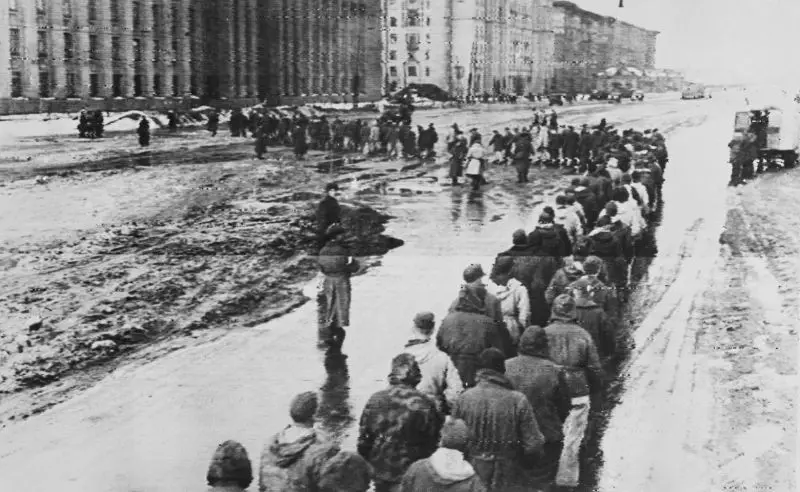
The “winners” who dreamed of capturing Leningrad, on the march of prisoners along the Moscow Highway (now Moskovsky Avenue). January 24, 1944
By the end of September 1941, the situation near Leningrad had generally stabilized. The Soviet command is strengthening its defenses, which the Germans and Finns cannot overcome with their existing forces. The German command relies on the blockade, artillery and Aviation. Ground forces burrow into the ground and begin trench warfare.
Troops of the Leningrad and Volkhov fronts carried out a number of operations in an attempt to break the blockade of the city. The Soviet armies attacked in the same directions for months and suffered heavy losses. However, mainly due to command errors, they were unable to break the blockade until the beginning of 1943.
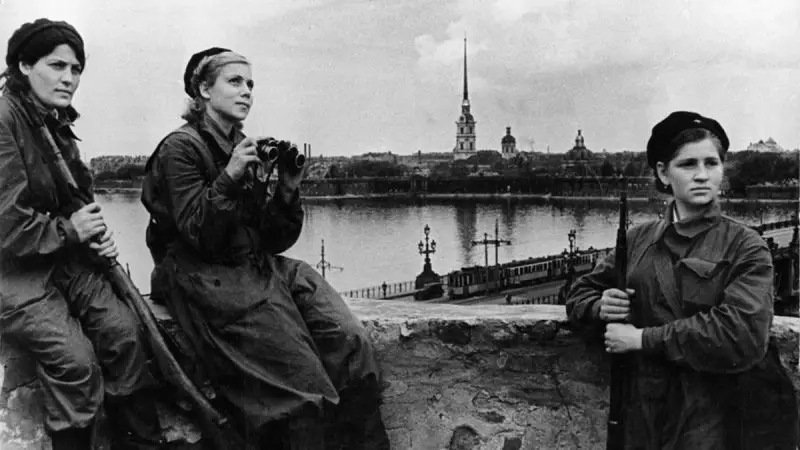
Female fighters of the local air defense (LAD) are on combat duty on the roof of house No. 4 on Khalturina Street (currently Millionnaya Street) in Leningrad. The Kirovsky Bridge (currently Troitsky) is visible behind. May 1942
Only in January 1943, Soviet troops, as a result of Operation Iskra, broke the blockade of Leningrad (Operation Spark. Assault on the "Ladoga Fortress"), but failed to completely free the city from the siege. The troops of the German 18th Army were in close proximity to Leningrad and continued intensive artillery shelling of the city and the Victory Road.
The Victory Road is a temporary Soviet railway line Polyany - Shlisselburg, which operated from February 5, 1943 to March 10, 1944 and served as a more effective replacement for the “Road of Life” for delivering goods to besieged Leningrad. Unlike the “Road of Life,” which ran along Lake Ladoga, the Victory Road ran along the left bank of the Neva and along the southern coast of Ladoga, passing in some sections 3–4 kilometers from German positions, for which it received the nickname “corridor of death.” She played an important role in the defense of Leningrad, including in the complete lifting of the blockade.
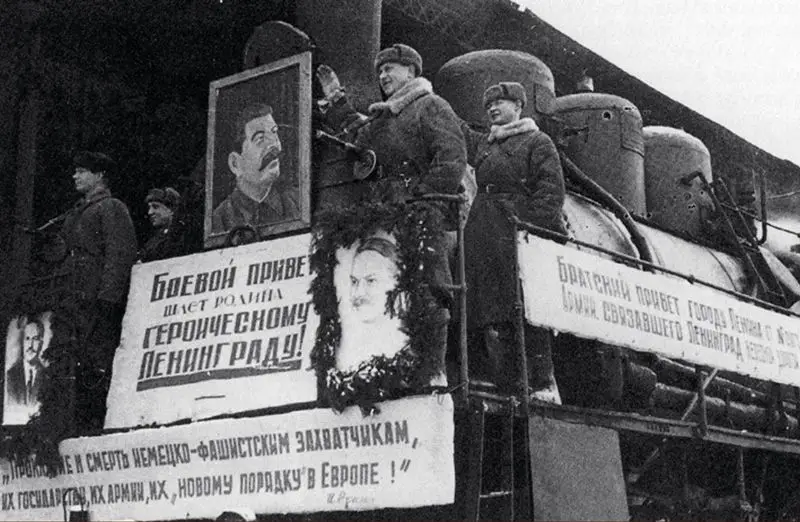
Steam locomotive Eu708-64 brought the first train from the “Mainland” to besieged Leningrad
“Leningrad is under siege!”
The situation was on the verge of complete disaster. The huge city, the second largest in the Union, one of the largest in the world, lost its railway and highway connections with the rest of the country. Sea routes froze. There are enemies in the north and south. The enemy has the shores of the Gulf of Finland.
The Germans and Finns broke through to the northern and southern shores of Lake Ladoga, located north and northeast of the city. They began to advance along the eastern shore. But they were unable to completely capture the lake. Our soldiers stopped them. Part of the eastern shore of Lake Ladoga remained in our hands. Here, along the water, along the lake, the road to Leningrad remained.
The road was long and difficult. The journey began in Vologda, where cargo was sent from all over the country. The trains went to Tikhvin and Volkhov, there was no further railway, the cargo was placed on river barges that traveled along the river. Volkhov. There is new unloading in Novaya Ladoga, from river barges to lake barges. Ladoga barges go to the western shore of the lake, where the port of Osinovets was located 55 km from Leningrad. A narrow gauge railway was built here. The cargo is being hauled back into the wagons, but there is another overload on the way. From a narrow gauge road to a regular railway, then to motor transport.
When the Germans took Tikhvin, this only difficult path was cut short. Then we made our way kilometer after kilometer through forests, ravines and swamps. Often the road went where only wild animals used to roam, in 20 days they laid a 200-kilometer road to Lake Ladoga. It began almost 100 km east of Tikhvin at the Zabor'e station and, bypassing Tikhvin captured by the enemy from the north, went to Lake Ladoga, to Novaya Ladoga.
In November 1941, frosts began, the "road of life" along the lake stopped. And without ammunition, fuel and food, the defense will fall. But our people began to move on the ice of Ladoga (as the lake was called). The path was dangerous: Ladoga was restless, capricious. A strong wind destroys the ice, cracks and gullies appear. Even the most severe frosts cannot completely shackle Lake Ladoga. But there is no way out. On November 22, the first automobile convoy (60 trucks) passed the ice. The vehicles covered 27 km of the dangerous ice path. The “road of life” was dangerous. Suddenly the ice broke, cars were drowning. German planes bombed the convoys.
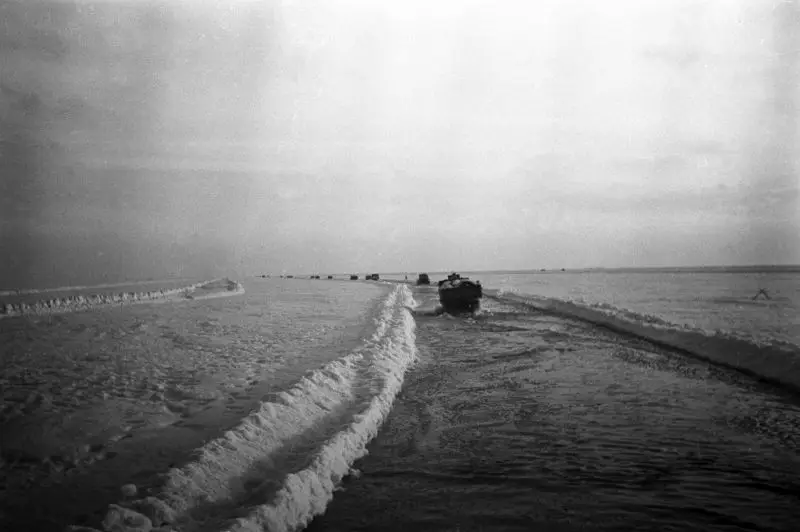
Cars on the water-ice route of Lake Ladoga - “The Road of Life”. April 1942
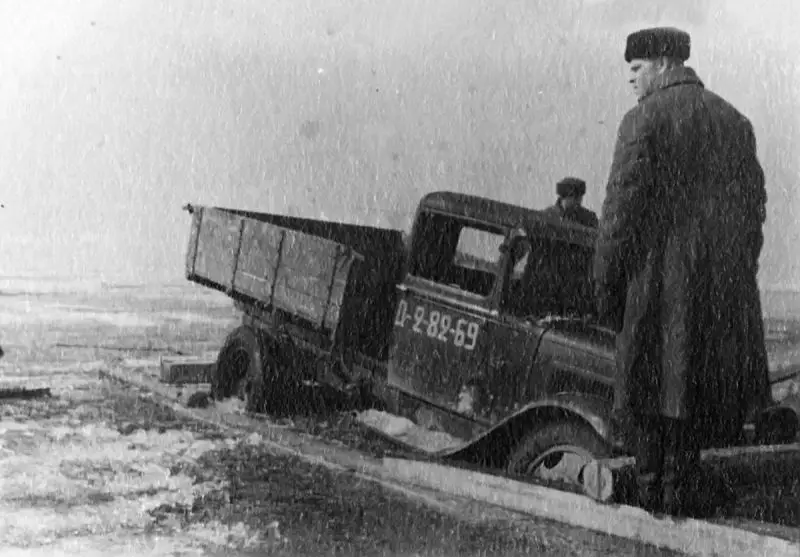
The process of extracting a GAZ-AA truck from a hole on the ice track of Lake Ladoga - the “Road of Life”. 1942
When our troops recaptured Tikhvin, cargoes again went by rail. But not immediately, it was necessary to restore the destroyed bridges between Tikhvin and Volkhov. Therefore, the cargos again went by car to bypass, but the path was already three times shorter. The road was restored to Voybokalo and Zhikharevo stations, which further reduced the distance. Then a railway was built to the lakeside village of Kobon. An ice road to Leningrad now ran from Kobona through Ladoga.
The days of siege were terrible for the townspeople. The Nazis constantly shelled and bombed Leningrad. Fires started in the city. Houses collapsed from shells and bombs. People died in homes and streets. There was no fuel, electricity stopped, the water supply was out of order. Hunger began. Death mowed people down.
In the winter of 1941, frosts in Leningrad were extremely severe. There was nothing to heat factories, theaters, schools and residential buildings. They used everything they could for fuel. Kiosks, fences, sheds were used for firewood, and some wooden houses were dismantled. Heating (heating) rooms were created to warm freezing people. On the street - one, two. They saved many Leningraders from death.
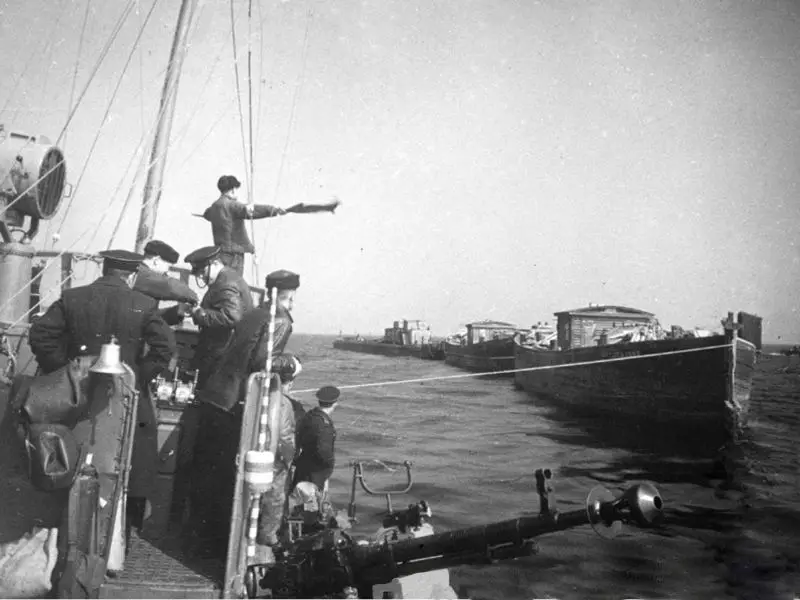
A small hunter of the MO-4 type tows barges with food for Leningrad. 1943
Soups were made from wild plants. We made pine “cutlets”. Siege bread was baked with various additives. Oatmeal, barley, soybean, and corn were added to rye flour, and flaxseed, cotton, and hemp cake were used. They used bran, sprouted grains, mill dust, rice husks, etc. The bread tasted sour, bitter and grassy. But hungry people dreamed of him.
Five times during the autumn-winter of 1941, the norm for bread distribution was reduced. On September 2, the first reduction took place: the norm was 600 grams of bread for adults, 300 grams for children. After 10 days, a new reduction: adults began to receive 500 grams of bread. In October, adults received 400 grams of bread, children - 200. In November there were two reductions: first, 300, then 250 grams of bread, adults began to receive, children - 125.
Despite all the horrors, the Leningraders held out. “Leningrad is under siege!” – the alarm bell rang across the country. The whole country tried to help the besieged city. Gifts came to Leningrad from the entire huge Union. The country helped the Leningraders as best it could.
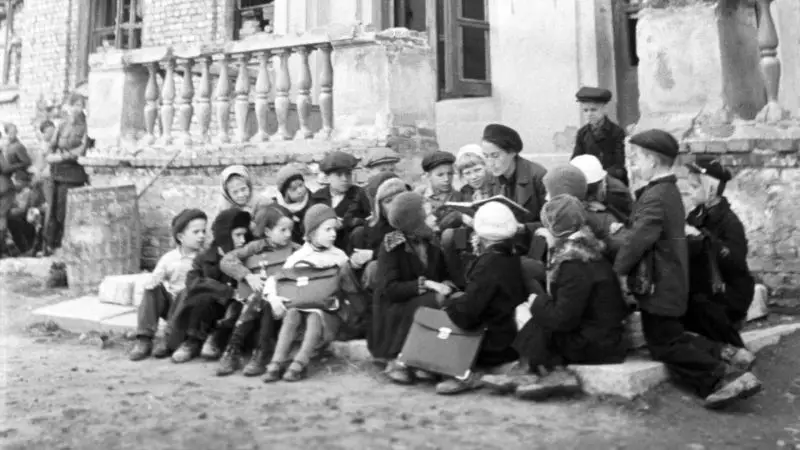
A lesson on the porch of a school destroyed by German shelling in besieged Leningrad. October 1943
What the defenders and residents of Leningrad experienced is difficult to imagine for people living in our time. The Nazis stormed the city, methodically destroyed it with heavy artillery fire, air raids, and subjected it to a severe blockade. However, the Leningraders survived!
According to various estimates, from 800 thousand to 1,5 million people died. The casualties among civilians were especially high. Thousands of people died from shells and bombs, but even more from hunger, exhaustion and cold.
The Battle of Leningrad was one of the decisive battles that buried Hitler's Barbarossa plan. Leningrad closed the way for the Germans and Finns in the northwestern direction of the Soviet-German front. This was a failure of Germany’s “blitzkrieg” strategy against the USSR.
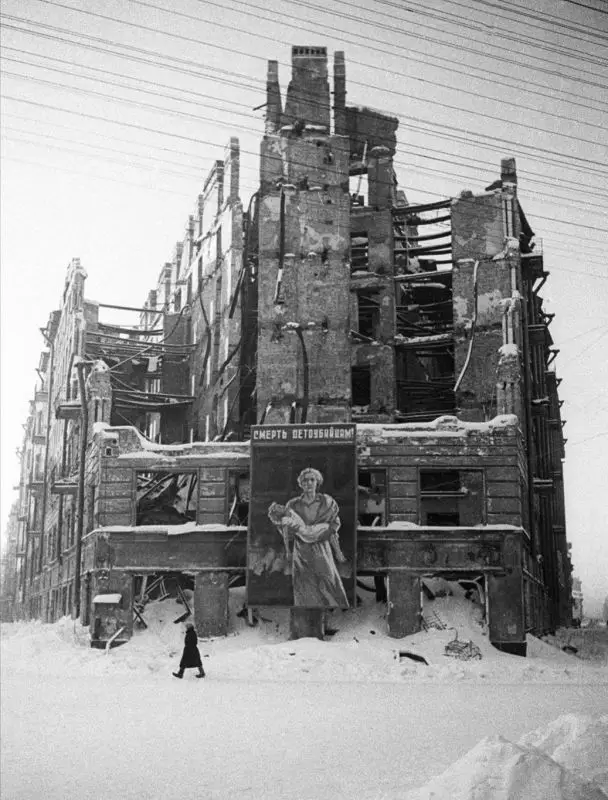
A residential building on Ligovsky Prospekt in Leningrad destroyed by German bombing. 1942
Complete liberation of the city
On January 14, 1944, the Krasnoselsko-Ropshinsky operation of the Leningrad Front began ("January Thunder" How the German 18th Army was driven back from Leningrad). Over the course of several days of stubborn fighting, the troops of the 2nd Shock and 42nd armies achieved a turning point in their favor and broke the enemy’s defenses.
The Germans began to withdraw their troops. In particular, troops are being withdrawn from the Mginsky ledge. The Peterhof-Strelna group of the 18th German Army was defeated. North of Krasnoye Selo, a German artillery group created specifically for shelling Leningrad was destroyed and captured.
Developing the offensive, from January 21, Soviet troops fought a stubborn battle for several days for Krasnogvardeysk, Pushkin and Slutsk, as well as on the Oktyabrskaya Railway line. On January 24, units of the 110th Rifle Corps captured Pushkin and Slutsk, and units of the 118th Rifle Corps of the 67th Army captured Ulyanovka. By January 29, units of the 54th Army of the Volkhov Front completely liberated the October Railway.
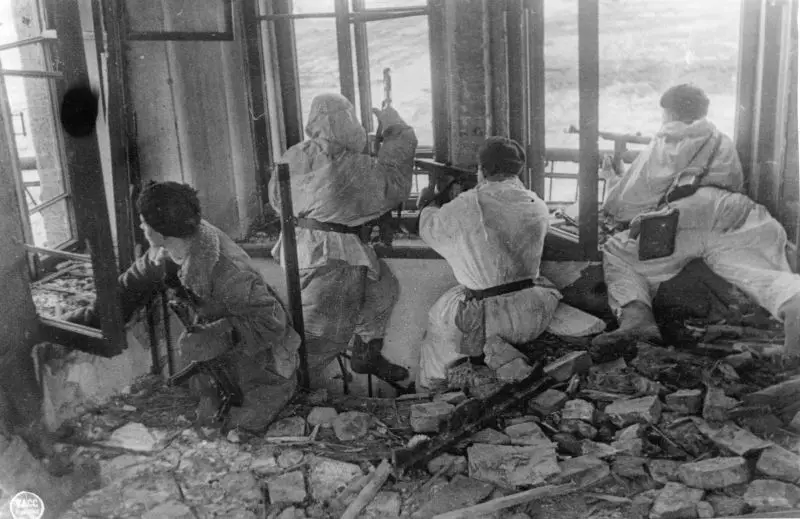
A group of Soviet machine gunners during street fighting in Krasnoe Selo. January 19, 1944
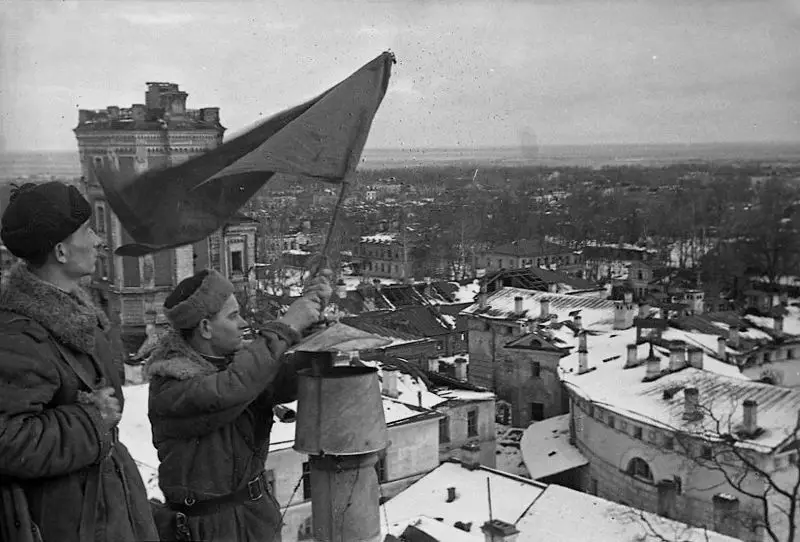
Soviet soldiers plant the Red Flag on the arch of the Lyceum in liberated Pushkin. January 24, 1944
On January 25, the 42nd Army, with the forces of the 123rd and 117th Rifle Corps, with the support of tanks, artillery and aviation, began the decisive assault on Krasnogvardeysk. Fierce street battles continued for almost a day. On January 26, Krasnogvardeysk was completely liberated. The front of the German army collapsed.
By January 30, 1944, Soviet troops broke through the enemy’s defenses on the front from the Gulf of Finland to Lake Ilmen and defeated the 18th German Army. In the southern direction it was possible to push the enemy back 100 km from Leningrad, in the western direction - 80 km. Many settlements were liberated, including Ropsha, Krasnoe Selo, Krasnogvardeysk, Pushkin and Slutsk.
Lindemann's German army split into two isolated groups: the main one, retreating to Luga, and the western one, retreating to Narva. 20 German divisions were defeated.
Back on January 21, 1944, the commander of the Leningrad Front L. A. Govorov and member of the Military Council of the Leningrad Front A. A. Zhdanov, without doubting the success of the further offensive, turned to the Supreme Commander-in-Chief I. Stalin with a request in connection with the complete liberation of Leningrad from the blockade and from enemy artillery shelling, authorize the issuance and publication of an order to the front troops on this occasion and, in honor of the victory, to fire a twenty-four artillery salvo from 27 guns in Leningrad on January 324.
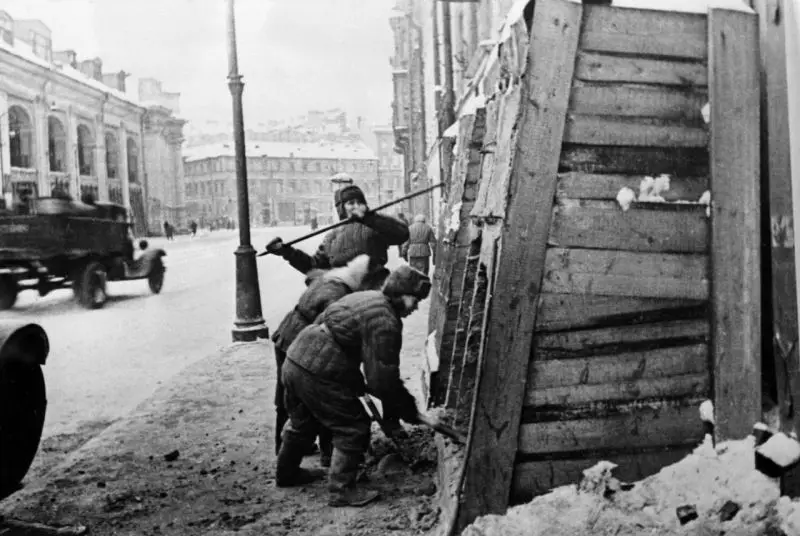
Removal of protective shelters from houses on Sadovaya Street in Leningrad. 1944
On January 27, an order from the Military Council of the Leningrad Front was read out on the radio, which spoke of the complete liberation of Leningrad from the siege. In the evening, almost the entire population of the city took to the streets and watched with jubilation the artillery salute that was fired in honor of this historical event.
War correspondent P. N. Luknitsky recalled:
We, soldiers and officers unfamiliar to each other, feeling like family and friends, are incredibly excited by this spectacle. We stand, look, remain silent, and my chest is constricted - it seems that for the first time in the entire war I want to cry.
When the fireworks ended, we shouted “Hurray!”, shook hands and hugged each other.”
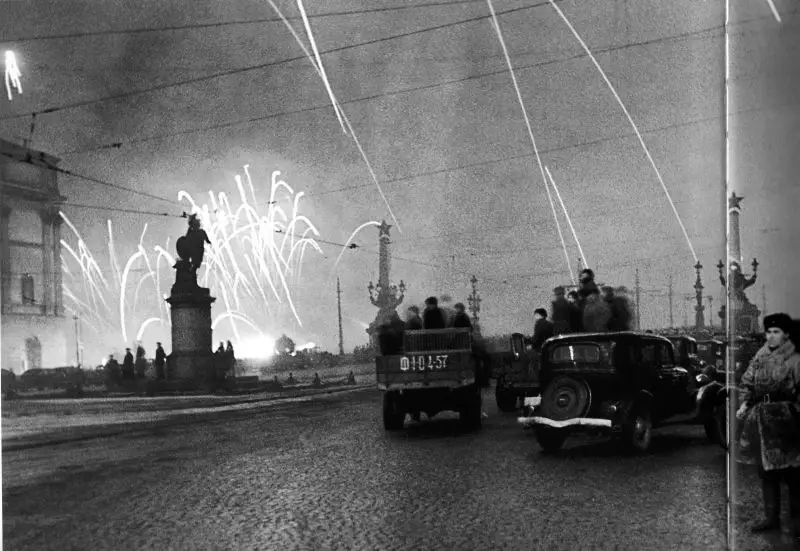
Leningraders on Suvorov Square watch fireworks to commemorate the lifting of the blockade. In the background you can see the lights of the Kirov Bridge (Trinity Bridge at present). On the left side of the photo is a monument to A.V. Suvorov. On January 27, 1944, in honor of the final lifting of the blockade in Leningrad at eight o'clock in the evening, a salute of 324 guns, consisting of 24 salvos, was given.
It is worth noting that the complete liberation of the Leningrad region occurred only in June-July 1944.
As a result of the Vyborg-Petrozavodsk operation (The fourth Stalinist blow: the defeat of the Finnish army) troops of the Leningrad and Karelian fronts, in cooperation with the Red Banner Baltic Fleet, the Ladoga and Onega military flotillas, broke through the heavily fortified enemy defenses, advancing 110 km on the Karelian Isthmus, and 200–250 km between Lakes Ladoga and Onega, liberating Vyborg and the capital of Karelo -Finnish SSR - Petrozavodsk.
Thus, having defeated the Finnish army, the Red Army completely eliminated the threat to Leningrad from the north and northeast.
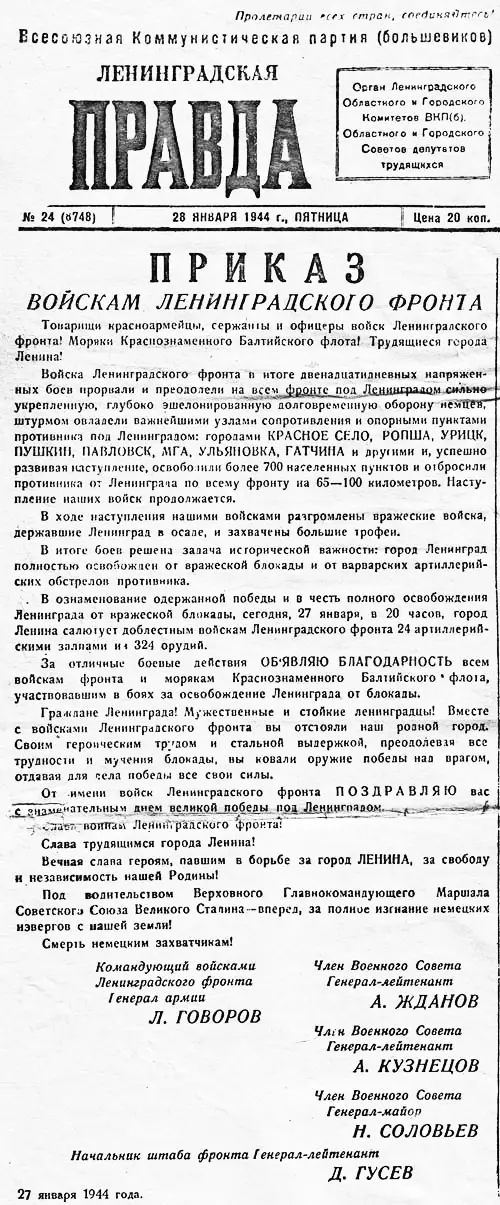
Order to the troops of the Leningrad Front dated January 27, 1944 on the complete liberation of Leningrad from the enemy blockade. Newspaper "Leningradskaya Pravda", January 28, 1944.
Information